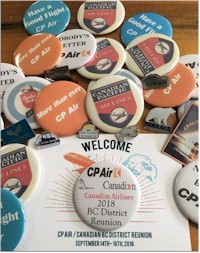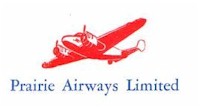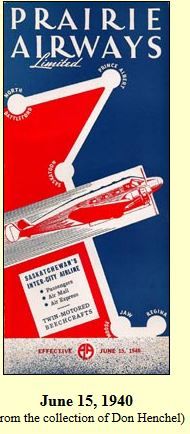|
This is an extension of what started as the YXY reunion in 2003 and now includes all the bases from YXS to YXY including YYE, YQH, YQU and YXT and YPR. Friday the 14th was Meet and Greet, Saturday the 15th was the dinner, attended by 89 people and on Sunday the 16th, brunch was available. Marlie has posted many photos on Facebook.com. The NetLetter has some posted here as well under "Reader Submitted Photos". In NetLetter #1398 we had an appeal from Marlie regarding the incident with CP Air 021 which CBC News with Ian Hanomansing was working on and were interested in speaking to anyone with a connection to the crash or anyone who may have information that could help shed light on this 50-year-old case. On Saturday, at the reunion, Johanna Wagstaffe from CBC came over to Parksville and interviewed 3 of the pilots and two women who were flight attendants during that time along with Jim Austin who was an Engineer. They were thrilled to be able to talk to them and did interviews from 1130 to 1530. They were looking to speak to people who flew during that time to find what it was like. What safety procedures were followed? What was it like to be a pilot and flight attendant at that time? Lots of pictures taken at the reunion and they are posted on CP Air FB. There is such a strong feeling of camaraderie after all these years and even the CBC staff commented on that. (Note: Terry Baker of the NetLetter team was invited to the Meet and Greet and can attest to the camaraderie amongst those present - eds) |
|
In the summer of 1935 the directors of the Moose Jaw Flying Club decided it would be a propitious time to set up a small airline specializing in charter and passenger flying. They hired member, Dick Ryan as manager and formed Prairie Airways. The airline initiated operation flying a DH Puss Moth and a high-wing Cessna monoplane. |
|
Late summer, 1940 -- Directors of Moose Jaw-based Prairie Airways began discussing an offer from Canadian Pacific Air Lines to purchase their firm. This was approved; Prairie's GM, Dick Ryan, joined CPA’s staff as manager of its Saskatchewan region, but soon was loaned to the management staff of 3 Air Observer School (AOS) in Regina. (See From Boxkite To Boardroom by Richard W. "Dick" Ryan.) This timetable issued in June 15, 1940 is from the collection of Don Henchell. (Source: timetableimages.com) |
|
In late 1941 Canadian Pacific Air Lines acquired Prairie Airways and its five aircraft (two Beechcraft S18D's, a Barkley-Grow T8P-1, a Cessna Airmaster and a Waco ZQC-6). (Sources: www.aerodacious.com and Saskatchewan Aviation Chronology 1940-49)
When the pilot got into deteriorating weather on January 28,1947 his windscreen iced up so badly that he couldn't see properly on landing and crashed near home base. The beloved “82” first had flown at Longueuil near Montreal on July 6, 1935. Twenty-four were built, including examples for Mexico and Argentina. (Source: Leslie Corness collection via Larry Milberry/CANAV Books) |
|
Captain Ralph Quick has sent us this memory - 18 Minute Search and Rescue. Sometime in the 1970’s F/O Brian Brownridge and I were approaching Watson Lake (YQH) in the Yukon. We were at 28,000 feet in a CP Air B-737 Flight 21 overflying YQH due to weather. Fog dominated the ground for as far as we could see. At YQH the weather was reported as ceiling obscured ⅛ of a mile in fog. As we came overhead I noted a hole in the fog about 1 ½ miles wide located 5 miles east of YQH on the Alaska Highway between YQH and Lower Post. About a minute past YQH we heard an American pilot call YQH on frequency 126.7 and saying “I'm on a road heading North and I have 20, maybe 30 minutes fuel left “. YQH replied he was not able to read him as he was breaking up. I called YQH on 122.2 and said we were reading him five square would you like us to take over. A relieved radio operator said sure and said that we should know that this pilot had left Whitehorse for Muncho Lake after strong recommendations not to, by the YXY Met Office. Also that he had reported by YQH eastbound for Muncho Lake 1hr and 20 mins ago. My reply was that should put him on the Smith River road (as it was the only road heading north that was east of YQH). He concurred. Before talking to the pilot made clear that we would do all talking to pilot on 126.7 and all talking to YQH on 122.2. What followed was an amazing sequence of events. Considering that from our altitude he could have been up to a 180 miles in any direction we had him safely on the ground on pavement 18 minutes after his initial call. Thanks to a cleaning lady he even had an RCMP car blocking the Alaska Highway for him. I can just see you wondering what a cleaning lady has to do with all this. To abbreviate the radio communications W- is Watson Lake Radio. First letter calling to... A E - what type of aircraft? So 3 minutes after first call we knew he was about 5 miles south of the Alaska Highway on the Cassiar road which intercepts just west of the town of Watson Lake. A E - be prepared to make right turn. The road you're on ends in a T just ahead of you. Report eastbound. I warned him because if he overshot the end of road out into the muskeg with low visibility and he tried a fast turn he would probably stall out at his low level. W E - how many cars have the RCMP got? This proved he didn’t have clue where he was (Muncho was 180 miles away and he had no fuel ) A E - just stay on the road (he was flying in 1/8th of a mile in fog and had to fly over the town) I had asked F/O to get me an airspace reservation 28,000 and below within 30 miles of YQH and now used this to do a rapid descent for the hole so that we could be in position to warn A if a car coming out of fog was going to hit him. Had kept passengers in loop with PA as to what was happening. A E - you will be coming out of the fog shortly and there could be a police car blocking road. As we approached the hole at 6,000 ft. above ground we could see a police flasher. No sooner saw that, than a dot appeared out of the fog. A E - have you in sight the police car ahead is blocking road for you. If you feel you have enough fuel would recommend a circuit “watch out for wires crossing road “. In all the Yukon this was a short stretch of road between two built up areas YQH and Lower Post that might have wires crossing road. The American went down to the end of clear air turned around and came back towards the police car. I expected him to land but he just kept on coming and soon he was in a position that a landing seemed impossible. All of a sudden he dived and then leveled off and I realized he was decelerating rapidly after landing. As he was only about 300 ft to the police car I said to Brian “he’s going to hit the car “. He must have had good brakes as somehow he stopped. First thing he said was “phew those wires were close “. The dive was to get under the wires. He said thank you for assistance and we continued to YXY. Captain Ralph Quick |

 Marlie Kelsey tells us that the CP Air/Canadian BC District Reunion was held at the Bayside Quality Resort Inn in Parksville on September 14 - 16, 2018.
Marlie Kelsey tells us that the CP Air/Canadian BC District Reunion was held at the Bayside Quality Resort Inn in Parksville on September 14 - 16, 2018.

